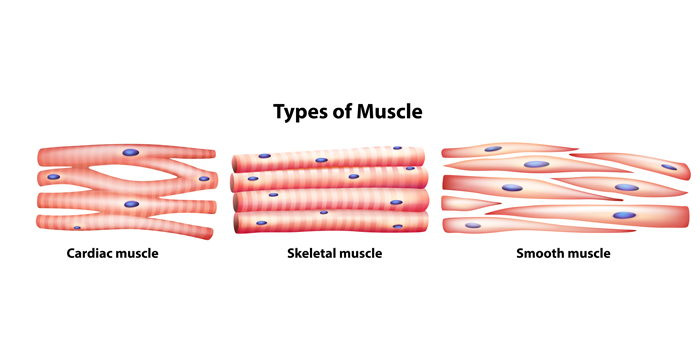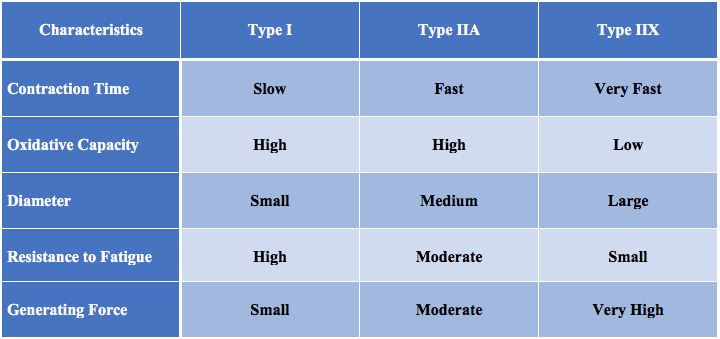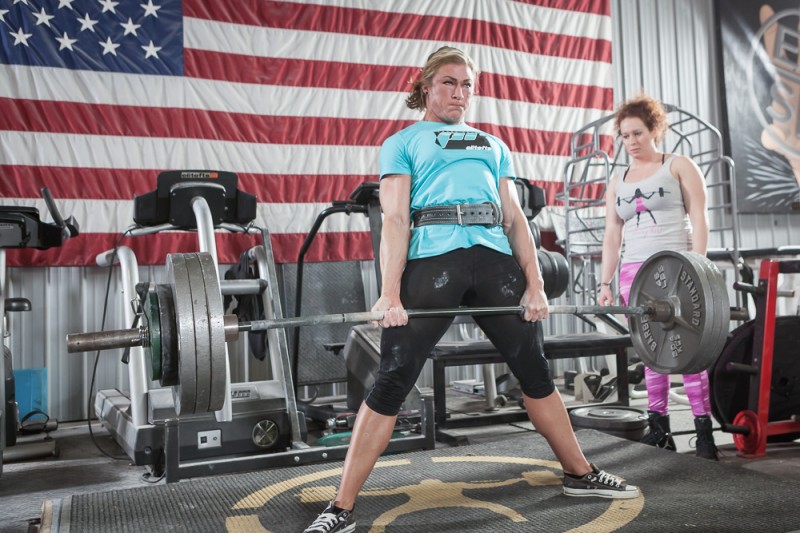
There are three types of muscles: striated (or skeletal), smooth muscle, and cardiac muscle. Unlike skeletal muscle, cardiac and smooth muscles are not under volitional control. Skeletal muscles are composed of slow and fast twitch muscle fibers. In this article I aim to explain the difference between slow and fast twitch muscle fibers and what impact training may have on them.
Slow Twitch Muscle Fibers
Slow twitch muscle fibers (also called Type I Muscle Fibers) contract slower, are very durable, and have a high resistance to fatigue. Slow twitch muscle fibers play a role in maintaining posture and are predominantly responsible for lower-intensity activities such as jogging. Why is that so? One of the reasons is the fact that such fibers have more mitochondria, a large oxidative capacity, and a slower release of ATP for energy. In addition, slow twitch muscle fibers have less ability to store glycogen. Because of mitochondria, aerobic ways of providing energy, and high blood flow, these muscle fibers appear red. As such, they are often referred to as red muscle fibers. But, the amount of force these muscles can produce is lower than that of fast twitch muscle fibers.
Fast Twitch Muscle Fibers
There are two types of fast twitch muscle fibers: type IIA and IIX (or IIB). This is a basic and most commonly used classification of muscle fibers. According to some authors, there is a more detailed classification. Staron and Hikida (1992) classify slow twitch muscle types to type I and type IC, and fast twitch muscle fibers to type IIA, IIB, IIC, IIAB and IIAC.
But for the purposes of this article, we will use only the classification of fibers to type IIA and IIX. Fast muscle fibers are often referred to as white muscle fibers.
Type IIA
Type IIA are also called oxidative-glycolytic since these muscle fibers use oxidative (aerobic) and glycolytic (anaerobic) mechanisms for energy. Type IIA fibers are activated predominantly during movements and activities that are quick, repetitive and of somewhat lower intensity. IIA fibers are activated after the type I. This type of muscle fiber has a relatively large amount of mitochondria and can quickly recover after activities.
Type IIX
Type IIX muscle fibers are fibers that are rapidly contracted and are activated during high-intensity activity, such as Olympic weightlifting. A small number of mitochondria, lesser oxidative and a greater glycolytic ability are characteristics that describe the type IIX fibers. It is important to understand that this fiber type gets tired very quickly, their recovery is slower, and occurs mainly after physical activity. However, in contrast to type I fibers, type IIX fibers have the possibility to generate a lot of force, and are almost exclusively responsible for overcoming maximum load.
RECENT: Tapering for a Powerlifting Meet
When we consider the composition of certain muscles, it is important to realize they are not made solely of fast or slow twitch muscle fibers, but of a combination of both. The exact ratio depends on a number of factors but generally speaking, certain muscle groups have more of one or the other. For example, calf muscles: soleus has more slow twitch muscle fibers than the gastrocnemius. Therefore, the primary function of soleus is walking and maintaining posture (i.e., activities that can last longer or are of lower intensity). Unlike soleus, gastrocnemius consists mainly of fast twitch muscle fibers, and is most activated during running, jumping, and other fast movements of feet.
Muscle Fibers and Training
One important aspect of all this is the question: How do muscle fibers react under the influence of training? The already known fact is that athletes engaged in endurance disciplines have a higher proportion of slow muscle fibers in relation to the fast fibers, and athletes engaged in Olympic weightlifting have a higher number of fast muscle fibers. Costill et al. (1976) found that the proportion of slow to fast twitch muscle fiber types in inactive people is 50/50. For athletes engaged in endurance disciplines, 60-70% of muscle fiber is type I, while a sprinter has 70-80% of type II muscle fibers.
This leads us to a cause vs. effect question: Was it the genetic component that led the person to one or another sport or is specific training that led to these differences? In other words, do good sprinters have the requisite genetic components because they've trained for sprinting, or do athletes with the requisite genetic components become good sprinters because they already possess those components?
Plasticity of muscle fibers reveals that there is a high probability of changing the muscle fibers from one to another type, of course when the muscle fibers are exposed to an appropriate stimuli. The most common change was detected from type IIA to type IIX and vice versa, and there is not a lot of evidence about the change of type I to type II.
One of the variables that can affect the change of fibers type I to type II is the rate of contraction. Liu et al. (2003) investigated the changes in muscle fibers of the long head of the triceps in 24 subjects, who had 3-5 months of training experience. The subjects were divided into two groups, both trained three times per week for a total of six weeks. The first group did every training 3 RM on the bench press, while the second group on Mondays did the same training as the first group. On Wednesdays they did 10 concentric repetitions on the bench press with 30% 1RM, and on Fridays they did 10 plyometric push-ups, with five sets per exercise.
Results showed the following:
In the first group there was a reduction of type IIX fibers and an increase in fibers IIA, with no change in the type I.
For the second group there was an increase of type IIA fibers and a reduction of type I fibers by 50% (from 18.2 to 9.2%).
These results suggest that high velocity of contraction is one of the variables that can affect changes in the muscle fibers. Training that includes high-velocity contraction explains why sprinters and weightlifters have a greater amount of fast muscle fibers than athletes in endurance sports.
What about changes from fast to slow?
Howald et al. (1985) explored the possibility of changes from fast to slow twitch fibers in 10 subjects. The subjects trained for six weeks, driving a bicycle ergometer for 30 minute, five times per week. After six weeks the results revealed an increase of 12% in the number of type I muscle fibers, and a reduction of type IIX by 24%. This data indicates the possibilities of changes from type II to type I.
Certain data tells us that physical inactivity can cause changes among muscle fibers (Hortobagyi et al., 2000), but this information is not as interesting as the impact of training on changes.
Conclusions
Based on recent findings, it is definitely possible to give specific recommendations for people who want to increase the amount of fast or slow twitch muscle fibers. The people who want to increase the amount of slow twitch muscle fibers should implement more training that is of lower intensity and longer duration. The higher amount of slow twitch muscle fibers will have a big impact on the performance in endurance sports.
Athletes who want to increase the amount of fast twitch muscle fibers need to focus their training to a higher intensity, and/or high velocity of contraction, with slightly lower volume. However, although there is evidence of the possibility of changing one type of fiber to another, there are many questions to which we do not know the answers.
Do specific muscle groups have a higher capacity of changing than others? Once you reach a change, is it constant? How much is it possible to change the ratio of fibers? Can a person who is born with 30% of fast muscle fibers increase the amount of fiber with training to 70-80%?
These are certainly interesting questions to which we can expect answers in the future.
References
- Costill, DL, Daniels, J, Evans, W, Fink, W, Krahenbuhl, G, and Saltin, B. (1976). Skeletal muscle enzymes and fiber composition in male and female track athletes. J Appl Physiol 40: 149-154
- Hortobagyi, T, Dempsey, L, Fraser, D, Zheng, D, Hamilton, G, Lambert, J, and Dohm, L. (2000). Changes in muscle strength, muscle fibre size and myofibrillar gene expression after immobilization and retraining in humans. J Physiol 524 Pt 1: 293-304
- Howald, H, Hoppeler, H, Claassen, H, Mathieu, O, and Straub, R. (1985). Influences of endurance training on the ultrastructural composition of the different muscle fiber types in humans. Pflugers Arch 403: 369-376
- Jacob M. Wilson, Jeremy P. Loenneke, Edward Jo, Gabriel J. Wilson, Michael C. Zourdos, Jeong-Su Kim. (2012). The effects of endurance, strength, and power training on muscle fiber type shifting. J Strength Cond Res. 26(6):1724-9.
- Liu, Y, Schlumberger, A, Wirth, K, Schmidtbleicher, D, and Steinacker, JM. (2003). Different effects on human skeletal myosin heavy chain isoform expression: strength vs. combination training. J Appl Physiol 94: 2282-2288
- Staron RS, Hikida RS (1992). Histochemical, biochemical, and ul-trastructural analyses of single human muscle fibers with special reference to the C fiber population. J Histochem Cytochem 40:563–568
Jozo Grgić is a Master of kinesiology with high interests in sport science. He is currently working as a professor at Fitness Academy in Zagreb, Croatia. He is also a Fitness index certified operator and an ACSM certified personal trainer.













Thanks for your comment. Composition of muscle fiber types is mainly measured with muscle biopsy. This is from Liu et al. (2003) from the methods section:
"Muscle biopsy was carried out at rest on a nontraining day, 3 days before and 7 days after the training protocols. Muscle samples were taken from the long head of m. triceps brachii of the dominant side of the subjects by using the fine-needle biopsy technique (20, 21). After routine disinfection of the skin, a 13-gauge biopsy needle (Peter
Pflugbeil Medizinische Instrumente, Zorneding, Germany) was punctured 1 cm into the muscle belly, and biopsy gauge was shot three times to attain 3 mg of muscle tissue. The
sample was immediately frozen in liquid nitrogen and then stored at 80°C.".
I think i would be best to try to get in contact with the authors for further directions.
You can find the full text of there work online.
What is your field of research?
It's a good informative session